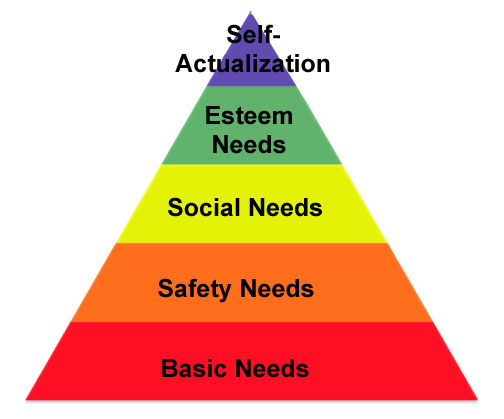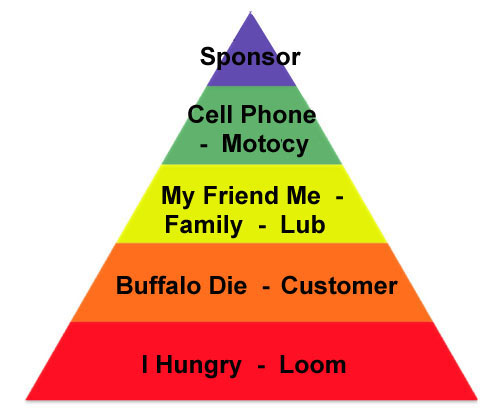Tags

- The difference in the hierarchy of human needs in the bar boy / customer paradigm is rife with danger.
Ever since Abraham Maslow proposed his Hierarchy of Human Needs theory in 1943, it has been misconstrued and misapplied by every industry that could possibly find an excuse to use pop psychology to explain what would be obvious if only they could pull their heads out of their collective ass. (A tradition which I will continue with this post.) Maslow’s theory of human needs is simple, easy to understand, and is basic common sense. Trying to tweak its conclusions is not necessary, but has been a favorite past-time among industry leaders since its conception.
Maslow’s theory’s success and popularity is largely due to the man’s understanding – even back when PowerPoint was just a gleam in Bill Gate’s eye – that the strength of a simple graphic to sell an idea can’t be beat. To that end, in addition to his original paper and his follow-up book, Motivation and Personality, published in 1954, Maslow presented the crux of his theory in graphical form, a pyramid with each tier forming the building blocks of what he considered the basic physiological and psychological needs of every human being.
Motivational speakers and management theory gurus are particularly taken with Maslow’s work, or at least with his doodles, and readily apply the graphical representation of his study to every type of employment environment from Walmart greeters to Wall Street bankers. Because his theory attempts to explain human motivation, they key in on the motivational aspect. But the needs Maslow describe apply in any given situation and to all humans, employed or not. It’s not so much about motivation as it is the pursuit of a fulfilled life.
Maslow’s theory states that are five levels of needs that must be met for goal attainment. The four lower levels are considered basic needs to survive and feel good about yourself, while the top level is considered a need of personal growth. Maslow theorized that the lower level needs must be satisfied before the higher order needs can affect behavior. In other words, for any human the needs of the bottom level must be obtained before concern over those on the next level are considered. The levels as shown in his pyramid, from the bottom up are:
- Physiological Needs: Basic life needs including air, food, water, shelter, sex, and sleep.
- Safety Needs: Includes safety, stability, security of environment, employment, personal and financial security, property ownership, and health and well being.
- Social Needs: Includes love, friendship, intimacy, family, community, and membership.
- Esteem Needs: Includes confidence, self-esteem, achievement, respect, status, and attention.
- Self-actualization: Covers personal growth and fulfillment, morality, creativity, etc.
While Maslow believed that the needs represented on each of the tiers must be met in order, once obtained, maintenance of those needs fluctuates widely. Additionally, any given behavior can satisfy several needs concurrently. For example, going to a bar could satisfy one’s needs for self-esteem and for social interaction.
In addition to maintenance, under stressful conditions, or when survival is threatened, people can regress to a lower need level. For example, when your partner ups and leaves you, it seems that love is again all you ever want. When you face bankruptcy after a long and happy life, you suddenly can’t think of anything except the cash you need to survive.
Some researchers have proposed that rather than looking at motivation, Maslow’s pyramid should be viewed as a series of steps in the pursuit of happiness. When a person has achieved the basic life needs of the first tier – their tummy is full, they have a roof over their head, and a place to sleep – they will be happy. But not for long. Achieving the needs of the next tier up is then required to maintain happiness so the person starts looking at financial security, personal safety, and health.
Once those needs are filled, again they are happy. But again that happiness is fleeting and they feel the need to find obtain more, in this case love, friendship, and community, the needs of the third tier of Maslow’s pyramid. These researches further state that while the first four tiers are about the pursuit of happiness, the fifth and final tier transcends to the pursuit of joy, and fulfillment, both of which are more rewarding and long lasting than a simple state of happiness.
Using the traditional levels of Maslow’s theory, one can better understand the motivation behind a Thai bar boy’s job and his spending the night with you. Or perhaps more aptly, your involvement in his pursuit of happiness. While your motivation may be due to the upper tiers of the pyramid, his undoubedly are nearer the bottom. While you may be trying to fill your need of love, he’s probably trying to fulfill his physiological and safety needs. Seldom will you both be on the same motivational level. Which explains why so many disgruntled customers complain about the walking ATM syndrome. They fail to take into account that the bar boy has needs of his own. And your wallet will satisfy many of his most basic and immediate needs.
That so many gogo bar customers are not satisfied is not surprising. In fact, Maslow provided for this in his theory. Most customers through age, status, and life experience have obtained the bottom four sets of needs on the pyramid and are in pursuit of pleasure, joy, and achievement. These folk on the self-actualization tier are concerned with truth, goodness, beauty, richness, self-sufficiency, and meaningfulness. Needs assigned to the lower levels have already been met. But those lower needs are sometimes expressed as situational needs and a gogo bar customer, even a self-actualizer, is seeking to fill a need found on the very bottom rung of the pyramid: sex.
Maslow said that when a self-actualizer doesn’t get these basic situational needs fulfilled, they respond with a list of problems as long as the ocean is wide; when forced to live without these values, the self-actualizer develops depression, despair, disgust, alienation, and a degree of cynicism.
Smells like an expat to me.
Many other experts in the field, including Geert Hofstede, criticize Maslow’s findings as being ethnocentric. His critics feel his theory fails to illustrate and expand upon the difference between the social and intellectual needs of those raised in individualistic societies and those raised in collectivist societies.
In the U.S., a highly individualistic nation, the needs and drives tend to be more self-centered than those in collectivist societies, such as Thailand, where the needs of acceptance and community will outweigh the needs for freedom and individuality. In their version of Maslow’s hierarchy, the esteem tier is removed and the self actualization tier is acknowledged as being concerned with individual competence for the betterment of the group as a whole; motivation is based on meeting societal development needs.
So a Thai bar boys needs are not only usually more basic than his customer’s, the entire structure of his pyramid is different. What we in the West see as the highest form of self fulfillment is not what is important to a Thai bar boy’s set of needs. Or at least to the majority of Thais’ set of needs. Bar boys are a bit different of a story.
Though bar boys follow the basic cultural needs of their broader society, their individualistic needs have been corrupted through familiarization with the western world. It’s not that they have subjugated their cultural list of needs to the needs of the Western world, but rather they have assimilated the needs of the West into their societal requirements for happiness. They may not be sure of why we do what we do, but they’ve seen what we have and want it too.
A Thai Bar Boy’s Hierarchy of Needs appears to be materialistic in nature. But emotional and societal needs are evident, too. In fact, they play an even higher role in a bar boy’s overarching needs. As a customer, you – and your wallet – are involved in meeting the basic needs of the bar boy. Seldom if ever are you needed in obtaining his higher level of needs. And if you are, your presence and needs take a back seat position to those of his family, friends, and country.
A good example is the ‘sponsor’ need at the top level of his pyramid of needs. You may mistranslate this to mean boyfriend. Regardless of the title, this need is not about you. It is about you providing for his actualization needs, which are actually about providing for those on the next lower level, his father and mother, siblings, wife, children, barmates, friends, and acquaintances.
Successfully navigating the waters of a Thai bar boy’s needs, for a Westener, is not just about your wallet. It’s also about knowing your place in his world and your duties in fulfilling his needs. Your need – an orgasm – is on the bottom rung of both of your sets of needs and as such is of little interest or concern.




Classic, just modern day classic…….love it.
Scary part is that it would appear accurate.
Could you do one specifically for the Pattaya desperates?
lol
Yup, Al, I think Maslow is rolling over in his grave right about now.
Can you put this in a PowerPoint presentation and email it to me. Thank
Is 😉
lol
Don’t remember which but read something about one of the European countries trying to ban PowerPoint recently.
this is fucking awesome piece of article.
Glad you enjoyed the post Djohn, and thanks for taking the time to leave a comment.
Your excellent bñog, put together and bound in hard covers, is material for A Doctorate’s Degree in “Thai Social Studies-Urban young male Migrants Integration …!!
Bravo
Rich , Buenos Aires
Thanks Rich!